Edible Flowers: Nasturtium Flowers
EATING NASTURTIUMS
Nasturtiums are brightly colored, cheerful flowers that are also fully edible. Both the leaves and the flowers of this plant are full of crunch and flavor.
The flowers pair sweetness and spice while the leaves deliver peppery punches. If you've never tried nasturtium, first experiment using the
leaves in salads and then try the flowers as a decorative topping.
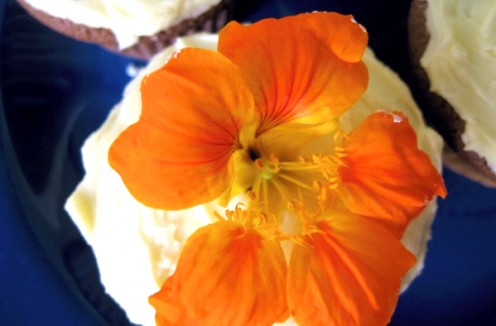
TASTE
Leaves: At first nibble, the the leaves taste mild and slightly sour. It's clear these aren't ordinary salad greens, though, as they have the odd effect of numbing the center of the tongue slightly. And it is then that the spice kicks in. It's not an unpleasantly hot or burning kind of spice, but it is very, very peppery. The taste lingers for a minute or more.
It's the level of pepperiness that might make a nose twitch and the eyes water in anticipation of a sneeze. That's apparently what was in the mind of those who used a Latin-inspired phrase to name the plant "Nose Twist."
Flowers: Nasturtium flowers are as spicy as they are colorful, but they are not quite as peppery as nasturtium leaves. The thin, tender petals are the mildest tasting part of the plant, mixing a soft pepper flavor with a light sweetness. The cone of the flower is almost syrupy sweet.
Stems: Nasturtium stems are rather tough and very spicy.
USING NASTURTIUMS
- The leaves can mixed into salads.
- The flowers can be used to decorate cakes.
- The leaves can be used to flavor vinegar.
- The flowers can be used as a garnish and as a salad topping.
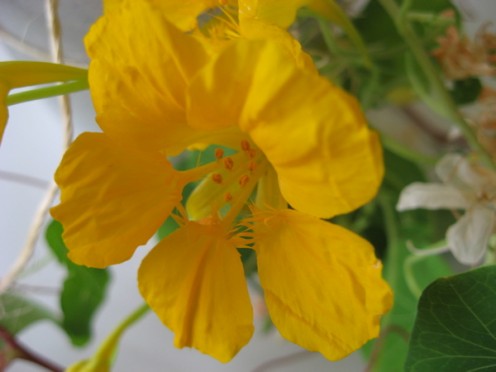
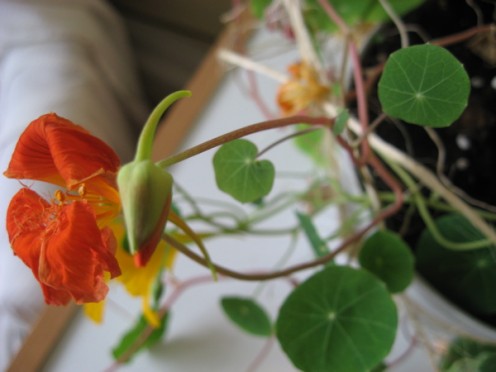
THE FLOWERS
Color: Most nasturtium flowers come in shades of yellow and orange. A few are so pale they appear whitish, and other are some are nearly a true red. On some flowers, one shade blends into another for a striking effect.
Structure: Nasturtium flowers have five petals each and a deceptive appearance of symmetry. The bottom three petals have little "whiskers" at their base and are propped up on little stalks attached to the flower stem, while the top two petals are smooth and marked with deeply colored veins. This is especially noticeable on deep orange nasturtium flowers: the veins are blood red, almost black. The top two petals come together offset from the stem and join up into a hollow, narrow cone that extends back for an inch or more behind the flower.
Note that a few (and uncommon) varieties of nasturtium have a double set of petals.
Smell: Nasturtiums have a surprisingly pleasant smell. It's a sweet, simple scent that's very much like honey. The only hint of spice to the flowers is something vaguely like cinnamon — like what a cinnamon stick might smell like if it were made into a nectar. It's a completely different thing from the peppery taste of the leaves.
Size: The flowers are about two inches in diameter; some less, some more.
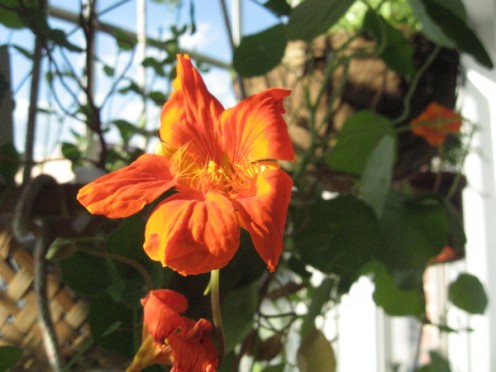
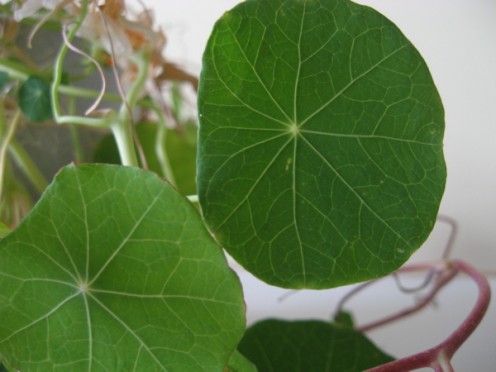
THE PLANT
Official name: Tropaeolum majus
Origin: South America
Leaves: The circular shape of nasturtium leaves is very distinctive. The leaves are like flat, slightly irregular saucers caught in mid twirl, balanced on top of each stem. The leaves have eight sections, but like with the flowers, the symmetry is imperfect. Several sections are always slightly smaller than the others, and the stem never quite hits at the exact center point. This gives the leaves their slightly lumpy outline. The leaves are a matte, grass green with whitish-yellow veins.
Stems: Nasturtiums have very juicy, relatively thick stems. Break off a leaf, and a thick, clear, syrup comes out. The stems are long and winding, twisting and turning in tight coils or large circles to help the leaves search out the sun. Their color appears purple from a distance, but up close, the stems are really pale green and flecked with streaks of pink.
Size: Climbing and trailing nasturtiums can appear spindly and winding. They'll extend many feet in all direction. Nasturtiums grown as a bush in a garden will be dense and may grow to be a couple feet high.
GROWING NASTURTIUMS
- Seeds sprout easily and grow quickly. Outdoors, nasturtiums work well climbing a trellis or fence. Indoors they'll trail nicely out of a hanging basket. They'll also grow in container or as a bush in a garden. Give them a little light and a little water, and they'll grow well.
- If a nasturtium plant is grown indoors, every leaf will turn to face the sun. Turn around the pot, and within a day or so, nearly every leaf will have flipped, too.
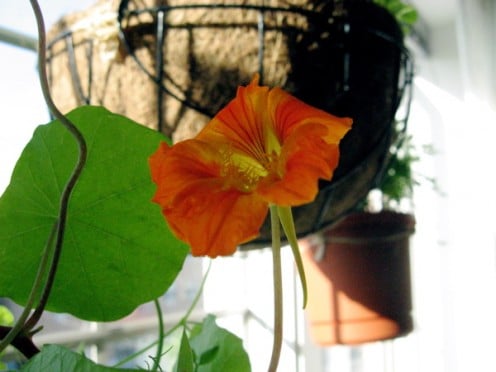

MORE ABOUT FLOWERS, HERBS AND GARDENS
- Mints: From Chocolate Mint To Peppermint
Mints are hardy, versatile herbs that come in a wildly varied range of shapes and flavors. Take fresh pineapple mint. It's as different from peppermint as it is from Standard Issue Toothpaste. - The One Window Herb Garden
Even if only one window in your house or apartment gets good light, it's possible to start an herb garden and find satisfaction in harvesting pinches and sprigs of your own homegrown herbs. - Starting a Culinary Herb Garden At Home
When you cultivate your own mix of fresh herbs, you'll be unconstrained by the varieties usually sold in a supermarket. The only limits are your time, patience and gardening skill. - Culinary Lavender
No spice lover should skip culinary lavender. That's especially so for spice fanatics who like a dash of hotness in their desserts. If you think mixing a bit of pepper into chocolate is an amazing idea, you may love baking with lavender. - Sweet Smelling Flowers: 7 Kinds of Fragrant Flowers
A guide to fragrant, sweet-smelling flowers: From lilacs to freesias, these flowers are treat for the nose. - Spring Flowers in Central Park
Spring flowers aren't impossible to find in New York City. April is the best month to see magnolias, tulips and lilacs in bloom in Central Park. - Death Valley Flowers: Spring Wildflowers in a Desolate Land
Death Valley National Park is a striking place, a place with extremes in topography and temperature. And some years, if the conditions are just right, the park erupts with a wild show of wildflowers.








